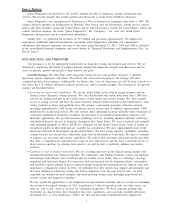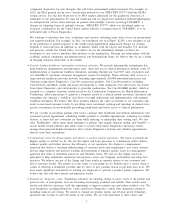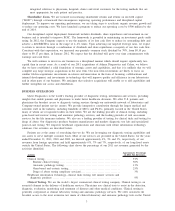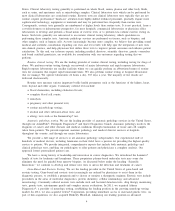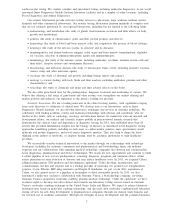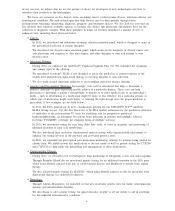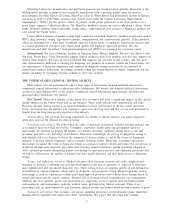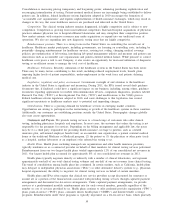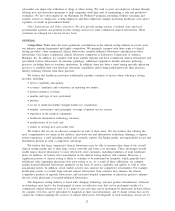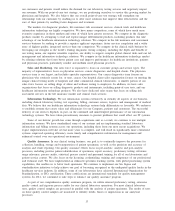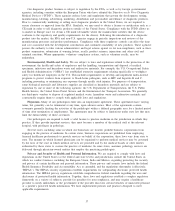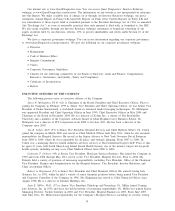Quest Diagnostics 2011 Annual Report Download - page 16
Download and view the complete annual report
Please find page 16 of the 2011 Quest Diagnostics annual report below. You can navigate through the pages in the report by either clicking on the pages listed below, or by using the keyword search tool below to find specific information within the annual report.Consolidation is increasing pricing transparency and bargaining power, enhancing purchasing sophistication and
encouraging internalization of testing. Patient-centered medical homes are increasingly being established to deliver
patient care. In addition, federal healthcare reform legislation adopted in 2010 encourages the formation of
“accountable care organizations” and requires implementation of health insurance exchanges, which may result in
changes in the way that some healthcare services are purchased and delivered in the United States.
Competition. The clinical testing industry remains fragmented, is highly competitive and is subject to new
competition. Competition is growing from non-traditional competitors. Increased hospital acquisitions of physician
practices enhance physician ties to hospital-affiliated laboratories and may strengthen their competitive position.
New market entrants with extensive resources may make acquisitions or expand into our traditional areas of
operations. We also are expanding into new diagnostic testing areas that are highly competitive.
Reimbursement pressure. There is a strong focus in the United States on controlling the overall cost of
healthcare. Healthcare market participants, including governments, are focusing on controlling costs, including by
potentially changing reimbursement for healthcare services, revising test coding, changing medical coverage
policies, pre-authorization of lab testing, introducing lab spend management utilities and payment and patient care
innovations such as accountable care organizations and patient-centered medical homes. While pressure to control
healthcare costs poses a risk to our Company, it also creates an opportunity for increased utilization of diagnostic
testing as an efficient means to manage the total cost of healthcare.
Healthcare Utilization. Recently, utilization of the healthcare system in the United States has been lower.
There may be many factors contributing to this result, including reduced employment levels, benefit plans
imposing higher levels of patient responsibility, under-employment in the work force and patients delaying
medical care.
Legislative, regulatory and policy environment. Government oversight of and attention to the healthcare
industry in the United States is significant and increasing. During 2011, the FDA issued several draft guidance
documents that, if finalized, could have a significant impact on our business, including, among others, guidance
documents regarding applications for mobile telecommunication devices, companion diagnostics, products labeled
Research Use Only (“RUO”) or Investigational Use Only (“IUO”) and modifications to the 510(k) process.
Federal healthcare reform legislation adopted in 2010, and court challenges to that legislation, has created
significant uncertainty as healthcare markets react to potential and impending changes.
Globalization. There is a growing demand for healthcare services in emerging market countries.
Opportunities are arising to participate in the restructuring or growth of the healthcare systems in these countries.
Additionally, our customers are establishing positions outside the United States. Demographic changes globally
also may create opportunities.
Customers and Payers. We provide testing services to a broad range of customers who order clinical
testing, including physicians, hospitals and employers. In most cases, the customer that orders the testing is not
responsible for the payments for services. Depending on the billing arrangement and applicable law, the payer
may be (1) a third party responsible for providing health insurance coverage to patients, such as a health
insurance plan, self-insured employer benefit fund, an accountable care organization, a patient centered medical
home or the traditional Medicare or Medicaid program, (2) the patient or (3) the physician or other party (such
as a hospital, another laboratory or an employer) who referred the testing to us.
Health Plans. Health plans, including managed care organizations and other health insurance providers,
typically reimburse us as a contracted provider on behalf of their members for clinical testing services performed.
Reimbursement from our two largest health plans totaled approximately 12% of our consolidated net revenues in
2011. Our largest health plan accounted for approximately 8% of our consolidated net revenues in 2011.
Health plans typically negotiate directly or indirectly with a number of clinical laboratories, and represent
approximately one-half of our total clinical testing volumes and one-half of our net revenues from clinical testing.
The trend of consolidation among health plans has continued. In certain markets, such as California, health plans
may delegate to independent physician associations (“IPAs”) or other alternative delivery systems (e.g., physician
hospital organizations) the ability to negotiate for clinical testing services on behalf of certain members.
Health plans and IPAs often require that clinical test service providers accept discounted fee structures or
assume all or a portion of the financial risk associated with providing testing services through capitated payment
arrangements and discounted fee-for-service arrangements. Under capitated payment arrangements, we provide
services at a predetermined monthly reimbursement rate for each covered member, generally regardless of the
number or cost of services provided by us. Health plans continue to offer preferred provider organization (“PPO”)
plans, point-of-service (“POS”) plans, consumer driven health plans (“CDHPs”) and limited benefit coverage
programs. Reimbursement under these programs is typically negotiated on a fee-for-service basis, which generally
10



